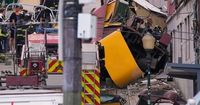Lisbon, Portugal—a city renowned for its pastel-colored buildings, winding hills, and iconic yellow streetcars—was plunged into mourning on the evening of September 3, 2025, after a devastating accident involving one of its most beloved landmarks. The Elevador da Glória, a historic funicular railway that ferries locals and tourists alike up the steep Rua da Glória, derailed and crashed, killing 15 people and injuring 18 others in what authorities have called the worst accident in the city’s recent history.
According to emergency services and the National Institute for Medical Emergencies, the crash occurred at about 6:15 p.m. local time, just as the evening rush hour began. Five of the injured were reported in serious condition, and a child was among the wounded. The identities and nationalities of the victims were not immediately released, but Portugal’s Ministry of Health confirmed that both local and foreign surnames appeared among the victims. The Spanish Ministry of Foreign Affairs later confirmed that two of the injured were Spanish citizens, as reported by Europa Press.
Eyewitness accounts painted a harrowing picture of the accident. Passengers and bystanders described the streetcar careening down the steep hill, apparently out of control, before crashing into a building on a sharp bend near Avenida da Liberdade. “It hit the building with brutal force and collapsed like a cardboard box; it had no brakes,” one witness told AFP, echoing the disbelief and shock that swept through the city. Another onlooker told SIC, a Portuguese TV channel, “It hit the building with brutal force and fell apart like a cardboard box…” The streetcar, with its sides and roof crumpled, lay on its side across the narrow road, a stark contrast to the cheerful sight it usually presents as it shuttles up and down the hill.
The Gloria funicular is more than just a mode of transport; it is classified as a national monument and has been a fixture in Lisbon since its inauguration in 1885. Electrified in the early 20th century, it now carries about three million people annually, including both residents and the roughly 8.5 million tourists who visited Lisbon last year. The line, operated by the municipal public transport company Carris, consists of two cars that counterbalance each other as they traverse the steep incline—a system prized for its efficiency and charm.
In the immediate aftermath of the crash, emergency crews responded rapidly, deploying 62 rescuers and 22 support vehicles to the scene. According to local reports, all victims had been transported to hospitals by 8:30 p.m., and by 9 p.m., police and emergency personnel had cleared the crash site. Videos and images shared widely on social media showed heavy smoke in the air, frantic passengers escaping the wreckage, and stunned onlookers gathering as news spread of the tragedy.
Authorities were quick to declare a period of mourning. Lisbon Mayor Carlos Moedas announced three days of municipal mourning, stating, “Lisbon is in mourning. The Lisbon City Council decrees three days of Municipal Mourning for the victims of the tragic accident at the Glória Funicular. I extend my heartfelt condolences to all the families and friends of the victims.” President Marcelo Rebelo de Sousa also expressed his condolences and solidarity with the families affected, calling the accident a tragedy that has left the entire country dismayed. The Portuguese government declared a national day of mourning for September 4, 2025, underscoring the profound impact the incident had on the nation.
International leaders and organizations joined in expressing their sympathy. European Commission President Ursula von der Leyen wrote, “It is with sadness that I learned of the derailment of the famous Elevador da Gloria.” Spanish Prime Minister Pedro Sánchez said he was “appalled by the terrible accident,” and Italian Foreign Minister Antonio Tajani expressed his solidarity with the victims after speaking to his Portuguese counterpart. The U.S. Embassy in Lisbon also offered its “deepest condolences to all affected.”
As the city reeled, attention turned to the cause of the disaster. The Lisbon Firefighters Regiment reported that the crash was caused by a “cable that came loose” in the funicular system, though authorities emphasized that it was too early to determine the precise cause. Carris, the operator, stated that all maintenance protocols had been followed, with the last major maintenance performed in 2022 and daily inspections carried out since then. However, Spanish newspaper El Pais reported that workers had previously complained about “poor maintenance” on the Gloria line, raising questions about the adequacy of safety measures.
With the investigation just beginning, Lisbon’s City Council acted swiftly to suspend all other streetcar operations in the city and ordered immediate inspections of similar systems. The move was meant to reassure the public and prevent any further incidents as authorities worked to piece together the sequence of events that led to the crash. According to the Associated Press, Carris promised that “all due diligence would be taken in finding the causes of the accident.”
The Gloria funicular’s derailment and the subsequent loss of life have cast a long shadow over Lisbon’s vibrant streets. The line, which connects the bustling downtown area near Restauradores Square with the lively Bairro Alto district, is an essential artery for both daily commuters and visitors eager to experience the city’s unique character. The crash site, once filled with the sounds of streetcars and chatter, was transformed into a scene of grief and reflection, with hundreds of tourists and locals stopping to pay their respects and capture images of the wreckage.
Funicular railways like the Gloria are a testament to human ingenuity, designed to conquer the steep gradients of hilly cities. The system’s two counterbalanced cars, tethered by steel cables, have reliably served Lisbon for generations. Yet, as this tragedy has shown, even the most beloved and time-tested infrastructure can be vulnerable to failure—reminding cities everywhere of the importance of rigorous safety protocols and constant vigilance.
As Lisbon observes its days of mourning, the focus now shifts to supporting the victims’ families, caring for the injured, and ensuring that the lessons learned from this catastrophe will help prevent another. For a city so defined by its history and its symbols, the loss at Rua da Glória is not just a local tragedy but a moment that resonates far beyond Portugal’s borders.

